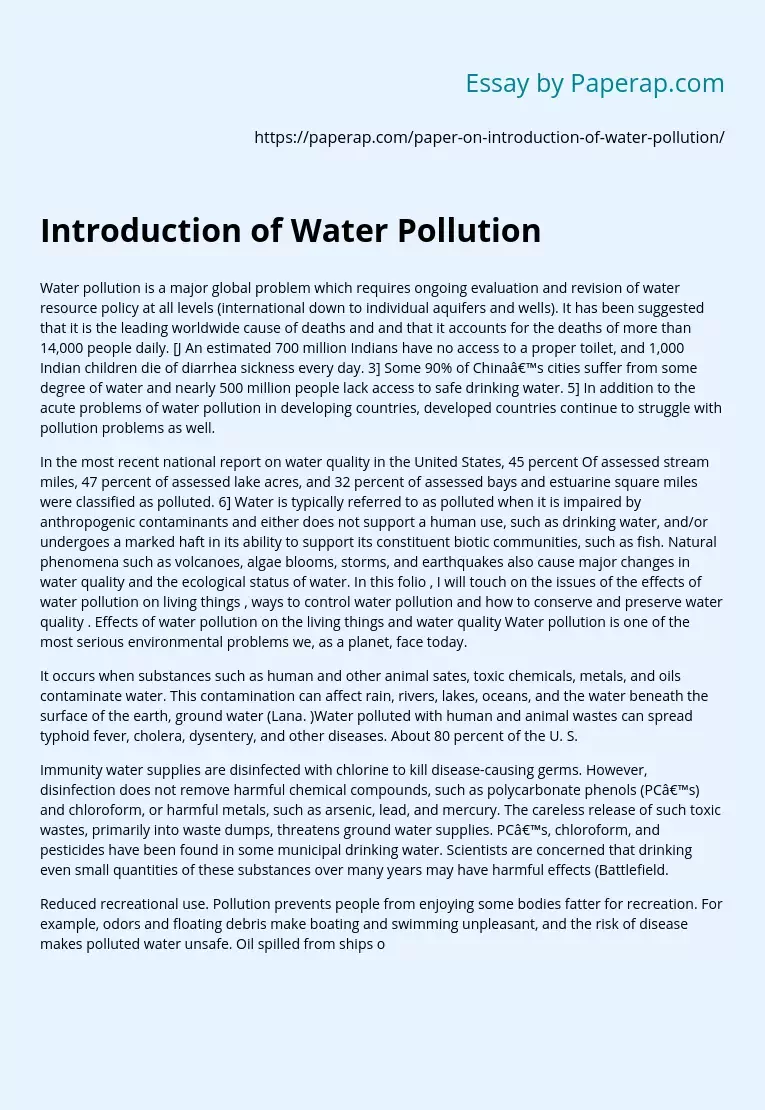Introduction of Water Pollution
Water pollution is a major global problem which requires ongoing evaluation and revision of water resource policy at all levels (international down to individual aquifers and wells). It has been suggested that it is the leading worldwide cause of deaths and and that it accounts for the deaths of more than 14,000 people daily. [J An estimated 700 million Indians have no access to a proper toilet, and 1,000 Indian children die of diarrhea sickness every day. 3] Some 90% of China’s cities suffer from some degree of water and nearly 500 million people lack access to safe drinking water.
5] In addition to the acute problems of water pollution in developing countries, developed countries continue to struggle with pollution problems as well.
In the most recent national report on water quality in the United States, 45 percent Of assessed stream miles, 47 percent of assessed lake acres, and 32 percent of assessed bays and estuarine square miles were classified as polluted. 6] Water is typically referred to as polluted when it is impaired by anthropogenic contaminants and either does not support a human use, such as drinking water, and/or undergoes a marked haft in its ability to support its constituent biotic communities, such as fish.
Natural phenomena such as volcanoes, algae blooms, storms, and earthquakes also cause major changes in water quality and the ecological status of water. In this folio , I will touch on the issues of the effects of water pollution on living things , ways to control water pollution and how to conserve and preserve water quality .
Effects of water pollution on the living things and water quality Water pollution is one of the most serious environmental problems we, as a planet, face today.
It occurs when substances such as human and other animal sates, toxic chemicals, metals, and oils contaminate water. This contamination can affect rain, rivers, lakes, oceans, and the water beneath the surface of the earth, ground water (Lana. )Water polluted with human and animal wastes can spread typhoid fever, cholera, dysentery, and other diseases. About 80 percent of the U. S.
Immunity water supplies are disinfected with chlorine to kill disease-causing germs. However, disinfection does not remove harmful chemical compounds, such as polycarbonate phenols (PC’s) and chloroform, or harmful metals, such as arsenic, lead, and mercury. The careless release of such toxic wastes, primarily into waste dumps, threatens ground water supplies. PC’s, chloroform, and pesticides have been found in some municipal drinking water. Scientists are concerned that drinking even small quantities of these substances over many years may have harmful effects (Battlefield.
Reduced recreational use. Pollution prevents people from enjoying some bodies fatter for recreation. For example, odors and floating debris make boating and swimming unpleasant, and the risk of disease makes polluted water unsafe. Oil spilled from ships or offshore wells may float to shore. It can kill water birds, shellfish, and other wildlife.
Water pollution also affects commercial and sport fishing. Fish can be killed by oil or by a lack of oxygen in the water, or they may die because of a reduction in the quantity and quality of their food supply. Industrial wastes, particularly PC’s, also harm fish (Gunning. ) Environmental water quality, also called ambient water quality, relates to water bodies such as lakes, rivers, and oceans. Water quality standards for surface waters vary significantly due to different environmental conditions, ecosystems, and intended human uses.
Toxic substances and high populations of certain microorganisms can present a health hazard for non-drinking purposes such as irrigation, swimming, fishing, rafting, boating, and industrial uses. These conditions may also affect wildlife, which use the water for drinking or as a habitat. Modern water quality laws generally specify protection of fisheries and recreational use and require, as a minimum, retention of current quality standards. There is some desire among the public to return water bodies to pristine, or pre-industrial conditions. Most current environmental laws focus on the designation of reticular uses Of a Water body.
In some countries these designations allow for some water contamination as long as the particular type of contamination is not harmful to the designated uses. Given the landscape changes (e. G land development , arbitration, accelerating in forested areas) in the watersheds of many freshwater bodies, returning to pristine conditions would be a significant challenge. In these cases, environmental scientists focus on achieving goals for maintaining healthy ecosystems and may concentrate on the protection of populations of endangered species and protecting human health.
Introduction of Water Pollution. (2018, Jan 30). Retrieved from https://paperap.com/paper-on-introduction-of-water-pollution/

